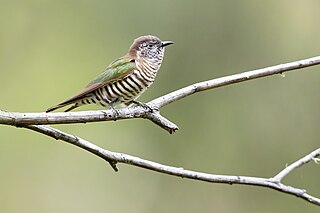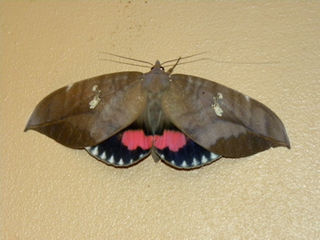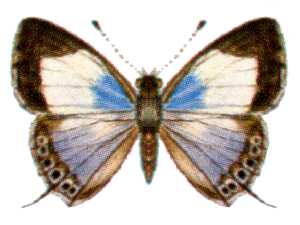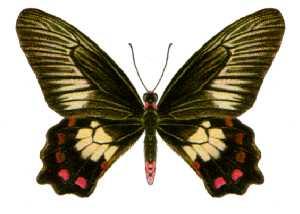
The common spotted cuscus, also known as the white cuscus, is a cuscus, a marsupial that lives in the Cape York region of Australia, New Guinea, and nearby smaller islands.

Papilio ulysses, the Ulysses butterfly, is a large swallowtail butterfly of Australia, Indonesia, Papua New Guinea and the Solomon Islands. Its size varies depending on subspecies, but the wingspan is about 10.5 cm (4.1 in) in Queensland.

Ornithoptera priamus, the common green birdwing, Cape York birdwing, Priam's birdwing, northern birdwing or New Guinea birdwing is a widespread species of birdwing butterfly found in the central and south Moluccas, New Guinea, Bismarck Archipelago, Solomon Islands, and north-east Australia.

Ornithoptera victoriae, the Queen Victoria's birdwing, is a birdwing butterfly of the family Papilionidae, found in the Solomon Islands and Papua New Guinea.

Apaturina is a monotypic genus of butterflies in the family Nymphalidae. Its sole species is Apaturina erminea, the turquoise emperor.
The angulate pipistrelle, also known as the New Guinea pipistrelle, is a species of vesper bat found in Papua New Guinea and the Solomon Islands.

The white-throated nightjar or white-throated eared-nightjar is a species of nightjar in the family Caprimulgidae. It is endemic to eastern Australia; it is a non-breeding winter visitor in Papua New Guinea. Its natural habitat is subtropical or tropical dry forests.

The shining bronze cuckoo is a species of cuckoo in the family Cuculidae, found in Australia, Indonesia, New Caledonia, New Zealand, Papua New Guinea, Solomon Islands, and Vanuatu. It was previously also known as Chalcites lucidus.

The northern common cuscus, also known as the gray cuscus, is a species of marsupial in the family Phalangeridae native to northern New Guinea and adjacent smaller islands, but is now also found in the Bismarck Archipelago, southeast and central Moluccas, the Solomons, and Timor, where it is believed to have been introduced in prehistoric times from New Guinea. It was formerly considered conspecific with the allopatric P. intercastellanus and P. mimicus.

Erysichton is a genus of butterflies in the family Lycaenidae. The species of this genus are found in the Australasian realm.

Ionolyce is a small genus of butterflies in the family Lycaenidae. I. helicon is widespread in the Indoaustralasian region (India to the Malay Archipelago. I selkon and I.brunnescens are both endemic to the Solomon Islands.

Philiris is a genus of butterflies in the family Lycaenidae. The species of this genus are found in the Australasian realm, mostly inhabiting tropical rainforests. Philiris was erected by Julius Röber in 1891. It is a speciose genus. Tite decided on 56 species. Sands added 11 species and placed the taxa into 21 species groups. Most species are on New Guinea. Tite considered Philiris and Candalides Hübner, 1819 to be sisters. Eliot (1973) placed Philiris in Luciini Waterhouse & Lyell, 1914, close to Hypochrysops C. et R. Felder, 1860. Compared to other members of the tribe, Philiris have relatively uniform ventral patterns with usually silvery-white ground color.

Phyllodes imperialis, the imperial fruit-sucking moth or pink underwing moth, is a noctuoid moth in the family Erebidae, subfamily Calpinae. It was first described by Herbert Druce in 1888. The species can be found in north-eastern Queensland to northern New South Wales, Papua New Guinea, Solomons, Vanuatu and New Caledonia.

Jameela is a genus of butterflies in the family Lycaenidae.

Pachliopta polydorus, the red-bodied swallowtail, is a butterfly from the family Papilionidae found in north-eastern Queensland, Australia and Papua New Guinea.

Candalides erinus, the small dusky-blue, is a species of butterfly of the family Lycaenidae. It is found in Australia and Indonesia.

Nacaduba cyanea, the tailed green-banded line-blue, is a species of butterfly in the family Lycaenidae, and formerly considered a member of the genus Danis. It is found in the Indonesia, Papua New Guinea, the Solomon Islands and Australia (Queensland).

Jamides cyta, the pale cerulean, is a butterfly of the lycaenids or blues family. It is found throughout South-east Asia, from Malaysia to the Solomon Islands and the Philippines, as well as Queensland in Australia.

Erysichton lineatus, the hairy line-blue, is a butterfly in the family Lycaenidae. It is the sole species of the genus Erysichton. It was first described by Richard Paget Murray in 1874. It is found in New Guinea and along most of the eastern coast of Australia, from Queensland to New South Wales.

Catopyrops ancyra, or Felder's lineblue, is a species of butterfly belonging to the lycaenid family described by Cajetan Felder in 1860. It is found in the Indomalayan and Australasian realms.


















